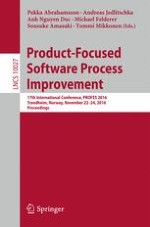2016 | OriginalPaper | Chapter
Evaluation of Kano-like Models Defined for Using Data Extracted from Online Sources
Authors : Huishi Yin, Dietmar Pfahl
Published in: Product-Focused Software Process Improvement
Publisher: Springer International Publishing
Activate our intelligent search to find suitable subject content or patents.
Select sections of text to find matching patents with Artificial Intelligence. powered by
Select sections of text to find additional relevant content using AI-assisted search. powered by
